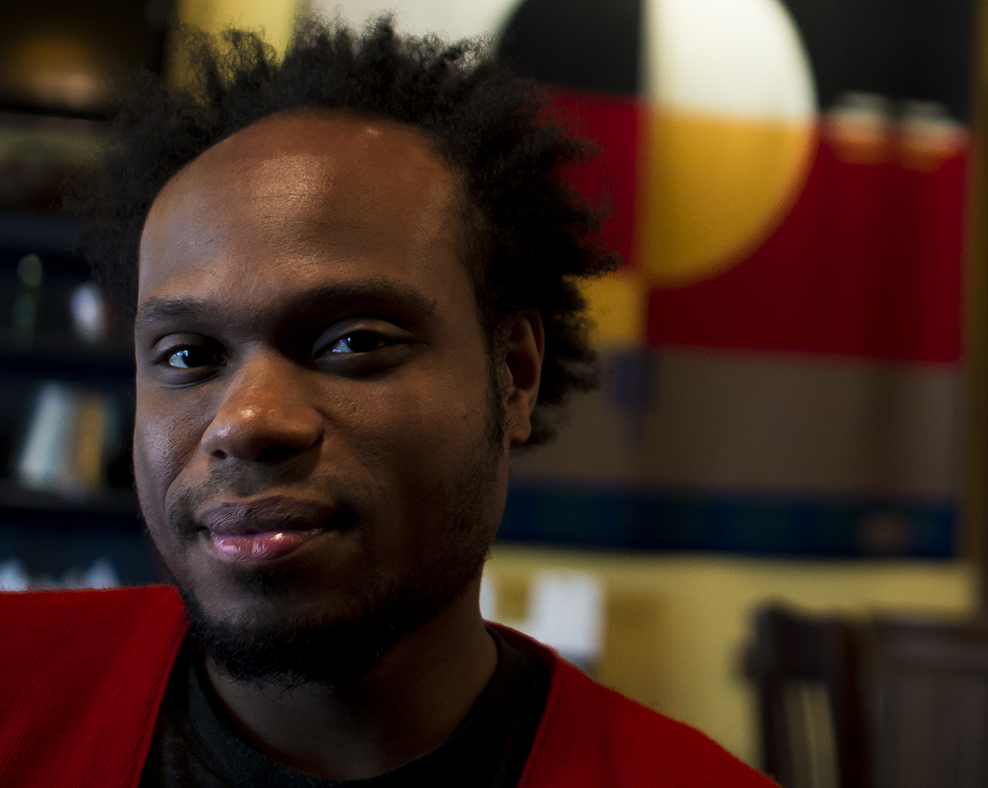P&W-funded Jamaal May is a poet from Detroit, MI, where he taught poetry in public schools and worked as a freelance audio engineer and touring performer. His poetry won the 2013 Indiana Review Prize and appears in journals such as Poetry, Ploughshares, and The Believer. Jamaal has earned an MFA from Warren Wilson and fellowships from Cave Canem and Bucknell University. His first book is Hum (Alice James Books, 2013), and he is founder of the Organic Weapon Arts Chapbook Press.
Most poetry readings happen on the heels of a new collection of poems. The question that’s come up lately as I give readings from my first book, participate in Q & A panels, and respond to interviews, is some version of “How did you put this thing together?” I’ve fussed and fretted over the manuscript, screened for multiple book prizes, looked over manuscripts for colleagues, and founded the Organic Weapon Arts Chapbook Series. After Hum won the Beatrice Hawley Award, I realized I had, in the process actually come up with some answers. What follows are considerations I wish I could share with my past self without breaking the space-time continuum. Hopefully presenting those thoughts here will grant them usefulness without the need of a scientific breakthrough at the Large Hadron Collider.
Writing Everything
Hum was written at different stages in different places through a variety of experiences. I figured out how poems spoke to each other way after the fact. Writing lots of kinds of poems early in your writing life can hone your voice and give you a broad body of work to draw from. Once you have a working manuscript, let new poems fill in various gaps or replace weaker poems. I’ve seen themed collections that felt over determined because there was no ebb and flow or tension between pieces. You’ll be surprised how poems that don’t seem to fit necessarily trouble the manuscript.
Aggressive Cutting
I’m not just talking about cutting failed poems or poems that aren’t quite there. Ask every poem in your book why they get a spot. “Because I was published” or “because I look like those other six poems” are not good enough answers. Try to get your book as close to the minimum page count as possible. If you still end up with a 110 pages, you’ll know it’s not just 60 strong ones and 50 pages of stuff you kind of think is ok, “but hey that teacher liked it so...” When you’re cutting poems you like because they do similar work to stronger poems, you’re close.
Also remember, most of us work in 8.5 x 11 word processor pages, so a single page poem may actually be two. I kept Hum just above the page minimum at 49 and I think the final version is somewhere around 75 pages.
Organic Ordering
A lot of books demarcate along logical lines: all the Goth sonnets in this section, all of the love poems about Magneto in this one, etc. Other collections may benefit from what C. Dale Young described to me as organic ordering. Look at images, tones, textures, recurring tropes, and other less expected elements that could link poems. It may be more exciting to see the third poem about Mussolini’s door knob if it surprises us in the last third of the book and has been further contextualized by your ode to Italian furniture.
Epigraphs
Be very picky about who gets quoted in your collection. I’ve seen many manuscripts over contextualize by heaping on epigraph after epigraph. One started with three lengthy quotes and then the opening poem had another. I’d read four paragraphs from a politician, two writers, and a philosopher before I saw a single line from the poet.
Fine-Tuning the Whole
Alan Shapiro pointed out that I had a habit of ending poems with three verb constructions. That's fine on its own but a bunch of poems in a row that end that will way feel samey. I recommend going through and reading the first two and last two lines of every poem. Do you always start with the same kind of syntax? Is the last line always a declarative sentence? How long are your first sentences? What about the last?
Personal Stock Language
I’ve started annoying myself with a game called “body count” where I count how many times the phrase “the body” appears at a poetry reading. I’m not trying to disparage its use, but to make sure what is repeated has resonance, we have to differentiate between recurring trope and default or placeholder words we instinctively latch on to. I searched Hum and asked myself if every “body” was absolutely not trying to be a “sternum” or “thigh” or “collar bone.” I had to ask every “something” in the book if it was sure it didn’t want to be a thing. Use wordcounter.com to find out what words you use the most in your manuscript. Like the poems that survive aggressive cutting, the “bodies” and “somethings” that stay will be vetted and necessary.
Photo: Jamaal May. Credit: Tarfia Faizullah.
Support for Readings/Workshops events in Detroit is provided by an endowment established with generous contribution from the Poets & Writers Board of Directors, and others. Additional support comes from the Friends of Poets & Writers.




